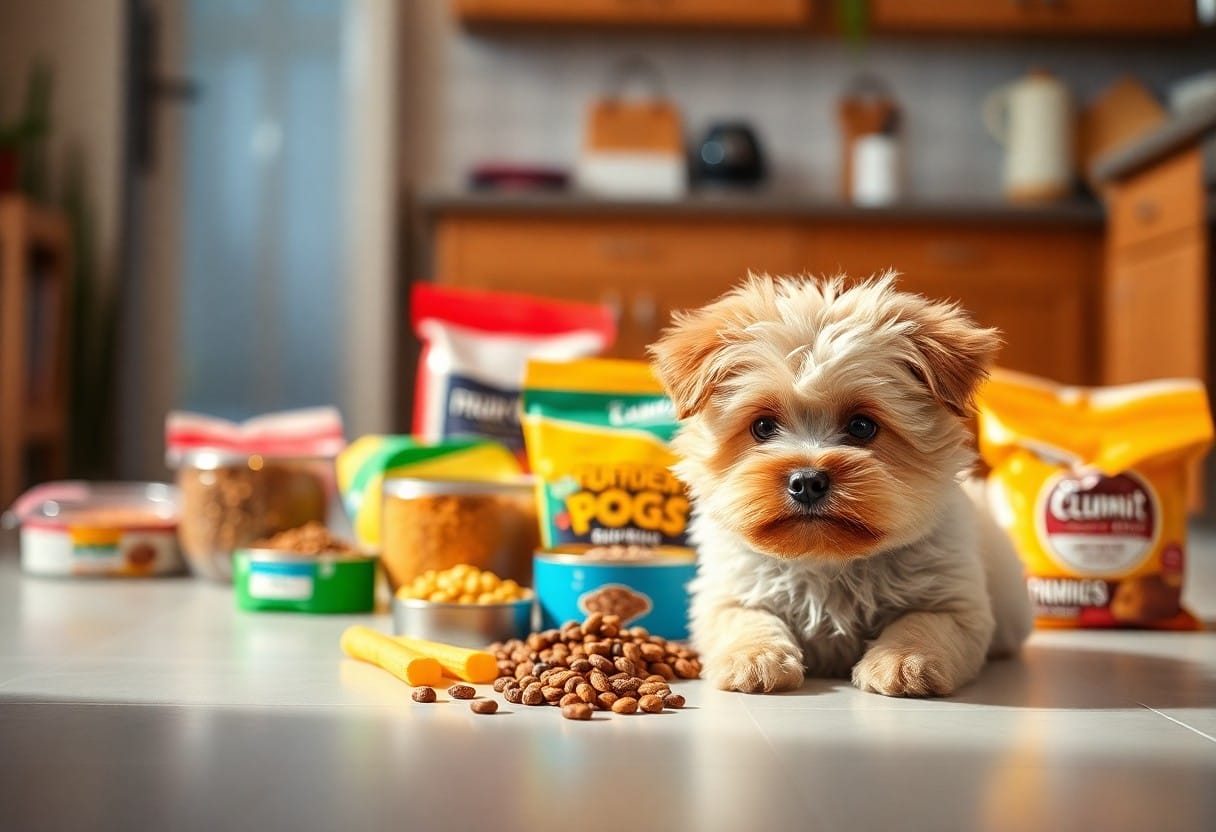
How to Deal with a Picky Eater Dog?
Share
Most dog owners face the challenge of a picky eater at some point, which can be a frustrating experience for both you and your furry friend. Understanding the reasons behind your dog's selective eating habits is vital for improving their diet and ensuring they receive proper nutrition. This guide will provide you with effective strategies for encouraging your dog to eat a more balanced diet, while also addressing any underlying health concerns that may be contributing to their unwillingness to eat. Let's probe practical solutions to help your dog enjoy mealtime!

Key Takeaways:
- Variety: Offer a range of flavors and textures to encourage your dog to try new foods.
- Routine: Establish a regular feeding schedule to help create a sense of predictability around mealtime.
- Positive Reinforcement: Use treats and praise to reward your dog for trying different foods, promoting a positive eating experience.

Understanding Picky Eating in Dogs
Before you can effectively deal with your dog's picky eating habits, it's vital to understand the various factors that contribute to this behavior. Picky eating in dogs can stem from a range of issues, from health concerns to behavioral traits. Recognizing the signs and symptoms associated with your dog's eating habits can allow you to take the right steps toward addressing the problem.
Common Reasons for Picky Eating
One of the primary reasons your dog may be a picky eater is the presence of underlying health issues. Conditions like dental disease, gastrointestinal disorders, or other medical problems can significantly impact your dog's appetite. If your dog is suddenly selective with food, a visit to the veterinarian is a good idea to rule out any health-related issues.
Another factor that can contribute to picky eating is the type of food you're offering. Dogs can become accustomed to specific flavors and textures, leading them to turn their noses up at anything unfamiliar. Additionally, if you frequently indulge your dog with table scraps or high-value treats, they may hold out for those delectable options instead of their regular dog food, further exacerbating their pickiness.
Assessing Your Dog's Diet
Your next step in tackling your dog's picky eating is to evaluate the food you provide. Start by examining the ingredients and nutritional value of your dog's current diet. Are you offering them high-quality food that meets their dietary needs? Consider whether the food is appropriate for your dog's age, size, and specific health needs. Additionally, keeping an eye out for allergies or intolerances is vital, as certain components can trigger digestive issues that contribute to their pickiness.
It's also wise to assess how frequently you change your dog's food. A *consistent diet* is generally more acceptable for dogs, while frequent switching can confuse them and create a sense of uncertainty around mealtime. Providing the same quality food over a period allows your dog to acclimatize, making them less likely to shy away from their meals. Always ensure that any food changes you make are gradual to promote digestive health and give your dog the best chance at a healthy appetite.
How to Identify Food Preferences
It's necessary to identify your dog's food preferences to ensure they get a balanced diet while delighting their taste buds. By paying attention to what your dog enjoys, you can make mealtime more enticing and reduce the chances of them becoming a picky eater. Understanding their likes and dislikes can also help prevent health issues arising from nutritional imbalances. This chapter will guide you through effective methods to recognize your dog's food preferences, helping you create meals they will actually eat.
Conducting a Taste Test
Assuming you want to determine your dog's food preferences, conducting a taste test can be an effective strategy. Begin by gathering a variety of dog food brands and flavors, as well as some healthy human foods that are safe for dogs, such as plain cooked chicken, carrots, or sweet potatoes. Serve a small portion of each food option in separate bowls, ensuring your dog has the opportunity to explore each one. Take note of their reactions and preferences as they taste each selection.
Monitoring Food Intake and Behavior
Even after conducting a taste test, it's important to keep an eye on your dog's food intake and behavior over time. Regular monitoring allows you to notice patterns in what your dog enjoys versus what they tend to avoid. Look for changes in their eating habits, such as the speed at which they eat and their enthusiasm for various foods. Positive changes can indicate that you are providing choices that suit their taste preferences, while lack of interest could signal the need to re-evaluate their diet.
To effectively monitor your dog's food intake and behavior, you can maintain a feeding journal documenting what foods you serve and how much your dog consumes each day. Note any changes in energy levels, coat condition, and even bathroom habits to assess their overall health. This detailed observation helps you to recognize which foods are well received and contribute positively to their health, allowing you to tailor their diet accordingly. Always ensure that the selections align with your veterinarian's recommendations to avoid introducing any potentially harmful foods into their diet.
Tips for Improving Your Dog's Appetite
Once again, dealing with a picky eater dog can be a challenge, but there are effective strategies to improve their appetite. Start by presenting the food in a appealing manner; dogs are more inclined to eat when their meals look and smell delicious. Try warming up their food slightly to enhance the aroma, or consider adding toppers like chicken broth or boiled eggs to entice them. Here are some quick tips you can implement:
- Experiment with different high-quality dog foods or brands.
- Check for any dietary restrictions or allergies your dog may have.
- Incorporate engaging feeding utensils, like puzzle bowls, to stimulate their interest.
- Limit treats to make meal times more appealing.
Enhancing Food Palatability
Appetite stimulation can often be achieved through enhancing the palatability of your dog's food. One effective way to do this is by incorporating a variety of textures. You might combine dry kibble with wet food or add some soft vegetables, making the meal more interesting for your pup. Experiment with various flavors as well; consider high-protein options like fish or liver, which can catch your dog's attention more easily than standard kibble. You may even find that mixing in some plain yogurt or cottage cheese can make mealtime feel more special.
Establishing a Feeding Routine
For your dog, establishing a consistent feeding routine is crucial in improving their appetite. Dogs thrive on predictability, so aim for a set mealtime schedule that remains unchanged daily. This helps signal to your dog that it's time to eat and fosters a sense of security surrounding their feeding. By keeping food availability limited to specific times, you can encourage your dog to eat during those windows rather than nibbling throughout the day.
Plus, setting a routine means you can monitor your dog's eating habits more effectively. If they consistently refuse food, it may be an indicator of an underlying problem that needs addressing. Ensure that meals are provided in a calm, distraction-free environment, as stress can significantly impact your dog's willingness to eat. Establishing a routine not only creates a positive habit for your pet but also provides an opportunity for you to bond and observe their behavior closely.

Factors to Consider in Dog Nutrition
Many dog owners often overlook the importance of understanding the fundamental aspects of your dog's nutrition. It is vital to consider the balance of ingredients in their meals to ensure they obtain all necessary nutrients. When you prepare your dog's diet, take note of these key factors:
- Life Stage: Puppies, adults, and senior dogs have different nutritional needs.
- Activity Level: An active dog might require a higher calorie and protein intake compared to a less active one.
- Breed-Specific Needs: Some breeds can be predisposed to certain health problems that might influence their diet.
- Health Conditions: Dogs with allergies or illnesses may need a special diet.
Assume that your dog's nutritional demands can change throughout their life, so it's necessary to consult with a veterinarian periodically. With Dr. Pashu , you can access expert veterinary advice anytime, ensuring your dog's diet is always tailored to their changing needs.
Nutritional Requirements for Different Breeds
With countless dog breeds, each has unique nutritional requirements tailored to their size, metabolism, and health risks. For example, small breeds often need a diet higher in calories to maintain their energy levels, while large breeds benefit from a diet designed to support their joints and overall bone structure. You may also find that specific toy breeds thrive on higher fat content, while working breeds might do best with protein-rich diets to fuel their active lifestyles.
It's also imperative to consider breeding tendencies, as some breeds are more susceptible to certain health concerns like obesity or skin conditions. Understanding breed-specific nutritional needs can help you make informed decisions about your dog's diet, ensuring they receive a balanced intake that supports a healthy lifestyle.
Impact of Age and Health Issues
An important aspect of evaluating your dog's nutrition involves their age and potential health issues. As dogs mature, their metabolism, energy levels, and specific nutrient needs evolve. Puppies, for instance, require a diet that promotes healthy growth, while senior dogs may benefit from low-calorie options rich in fiber to manage their weight. Furthermore, age can bring about health complications, affecting your dog's need for certain nutrients.
Just like humans, dogs can feel unwell too, but they express it in unique ways. Learn how to recognize the signs and understand your dog’s health better with this insightful guide on can dogs feel ill.
For instance, older dogs may struggle with arthritis or kidney disease, necessitating diets that are lower in protein or enriched with joint supplements such as glucosamine. Keeping track of changes in your dog's health and working closely with your veterinarian will equip you to adjust their diet as necessary to cater to their individual health concerns and ensure their overall well-being.
Exploring Various Feeding Methods
Unlike humans, dogs have different preferences and needs when it comes to feeding. As a pet owner, understanding these differences can help you select the most suitable feeding method for your picky eater. By exploring various feeding strategies, you can tap into your dog's instincts, allowing them to engage more positively with their food, while also ensuring they receive the right nutrition tailored to their preferences.
Free Feeding vs. Scheduled Feeding
On one hand, free feeding allows your dog to graze throughout the day, offering them the flexibility to eat when they feel hungry. This method can work well for some dogs, especially those who self-regulate their food intake. However, it may also lead to overindulgence or the development of bad habits, such as refusing to eat when food is presented at certain times. On the other hand, scheduled feeding can promote a healthier routine by providing structure, which often encourages your dog to eat their meals promptly. By setting specific feeding times, you can monitor their appetite and ensure they maintain a well-balanced diet.
Interactive Feeding Techniques
The interaction between you and your dog during meal times can play a significant role in their willingness to eat. Incorporating interactive feeding techniques can turn mealtime into a stimulating activity, making your dog more likely to enjoy their food. Options such as puzzle feeders, treat-dispensing toys, and feeding games can provide mental and physical challenges that make eating a fun experience. These methods can also slow down their eating, which can be beneficial for digestion and help to prevent bloating.
Looking for a nutritious and delicious meal option for your furry friend? Discover why Pawpeye's wet food gravy is the best choice for keeping your dog happy and healthy!
Techniques like using a puzzle feeder can engage your dog's natural problem-solving skills and create a sense of accomplishment when they access their food. Similarly, rotating the types of interactive toys you use can keep their mealtimes interesting. Just ensure that whatever method you utilize remains safe and free from any small parts that could pose a choking hazard. Keeping an eye on their overall behavior during feeding times will help you assess whether these interactive methods are positively impacting their eating habits and general enjoyment of food.
Consulting a Veterinarian
When to Seek Professional Help
Even if your dog has a tendency to be a picky eater, it's important to identify when their refusal to eat may signal a more serious issue. If your pet goes longer than 24 hours without eating or shows signs of distress such as vomiting, lethargy, or diarrhea, it's time to consult a veterinarian. These could be signs of an underlying health concern that needs immediate attention, and early intervention is often key to successful treatment.
Potential Medical Issues
Seek the advice of a veterinarian if your picky eater's eating habits seem unusual or accompanied by other concerning symptoms. Various medical conditions such as dental problems, gastrointestinal issues, or infections can affect your dog's appetite and willingness to eat. Your vet will perform a thorough examination to rule out any potential health problems and provide guidance on suitable dietary adjustments or treatments.
To ensure your dog remains healthy, you should be aware of common medical issues that can lead to a change in appetite. Dental disease can cause pain while eating, while gastrointestinal issues may lead to discomfort. In some cases, infections or illnesses can manifest as a decreased interest in food. By consulting with your veterinarian, you can gain vital insights about your dog's health and make informed decisions regarding their care. This proactive approach can ultimately help maintain your pet's overall well-being.
Final Words
Considering all points, tackling the issue of a picky eater dog can be both challenging and rewarding. It's vital to establish a consistent feeding routine that meets your dog's nutritional needs while also catering to their preferences. Experimenting with different types of food, textures, and flavors can help you discover what your dog enjoys the most. Mixing in wet food or adding small amounts of flavorful toppings can also enhance the appeal of their meals, making mealtime a more exciting experience for your furry friend.
Moreover, it's important to maintain a positive attitude throughout this journey. Be patient and avoid turning mealtimes into a battleground. Instead, encourage your dog by using praise and creating a calm eating environment. If you notice persistent issues, consulting your veterinarian could help identify any underlying health concerns that might be affecting your dog's appetite. Ultimately, your dedication and understanding will make a significant difference in ensuring your dog develops a healthy relationship with their food.
Frequently Asked Questions
What are some common signs of a picky eater dog?
A: Picky eater dogs may display various behaviors, such as sniffing their food but not eating it, leaving food uneaten, or only eating certain types of food while ignoring others. They might also show signs of disinterest during mealtime or show excitement at the prospect of a treat but ignore their regular dog food.
How can I encourage my picky eater dog to eat?
A: To encourage a picky eater dog to eat, try incorporating a variety of flavors and textures in their food. Mixing in wet food with dry kibble or adding low-sodium chicken broth can entice them. Another idea is to establish a consistent feeding schedule, which may help your dog feel more comfortable and eager to eat during mealtime.
Should I be concerned if my dog is a picky eater?
A: It's important to consider your dog's overall health when they are a picky eater. If your dog consistently refuses to eat or loses weight, it may indicate an underlying health issue, and consulting a veterinarian would be advisable. A vet can rule out any medical concerns and provide guidance on proper nutrition for your pet.
Are there certain dog food brands that are better for picky eaters?
A: Some dog food brands are specifically formulated to appeal to picky eaters by using high-quality, palatable ingredients. Look for foods that include real meat as the first ingredient, as well as those that have been highly rated for taste by other pet owners. Sample packages or trial sizes can also help you determine what your dog prefers without committing to a larger quantity.
How do treats factor into managing a picky eater dog?
A: Treats can play a significant role in managing a picky eater dog. Offering treats as a reward for eating their meals can create positive associations with mealtime. Additionally, you can use treats to introduce your dog to new flavors and textures they might not be willing to try in their regular food. However, ensure that treats do not exceed 10% of their daily caloric intake to maintain a balanced diet.
